Abstract
The 359 nucleotides (nt) long potato spindle tuber prototype viroid (PSTVd) is sensitive to experimentally introduced mutations as the substitution or deletion of a single nucleotide usually abolishes its infectivity, although certain sequence alterations are tolerated. This is illustrated by the fact that viroid progeny can evolve in planta upon inoculation with substitution mutants generated in vitro, and by the existence of genetically stable 356-360 nt long PSTVd field isolates. However, to date, no viable in vitro-generated deletion mutant of PSTVd has been reported. We have now found a 341 nt long infectious PSTVd RNA replicon that evolved in agrotransformed plants transformed with the dimeric form of an in vitro-deleted, non-infectious 350 bp long PSTVd cDNA unit by an additional complementary deletion of 9 nt in vivo. This is the first report that the deletion-abolished infectivity of a viroid is restored by an additional deletion that concurrently restabilized its perturbed secondary structure by abandoning an internal segment of the rod-like molecule. The fact that approximately 5% of the total PSTVd RNA genome was deleted demonstrates that the maintenance of this viroid-specific rod-like structure is not only essential for nuclease protection but also for the infectivity, i.e. transmissibility, replicability, processibility and pathogenicity of these minimal infectious agents.
Full text
PDF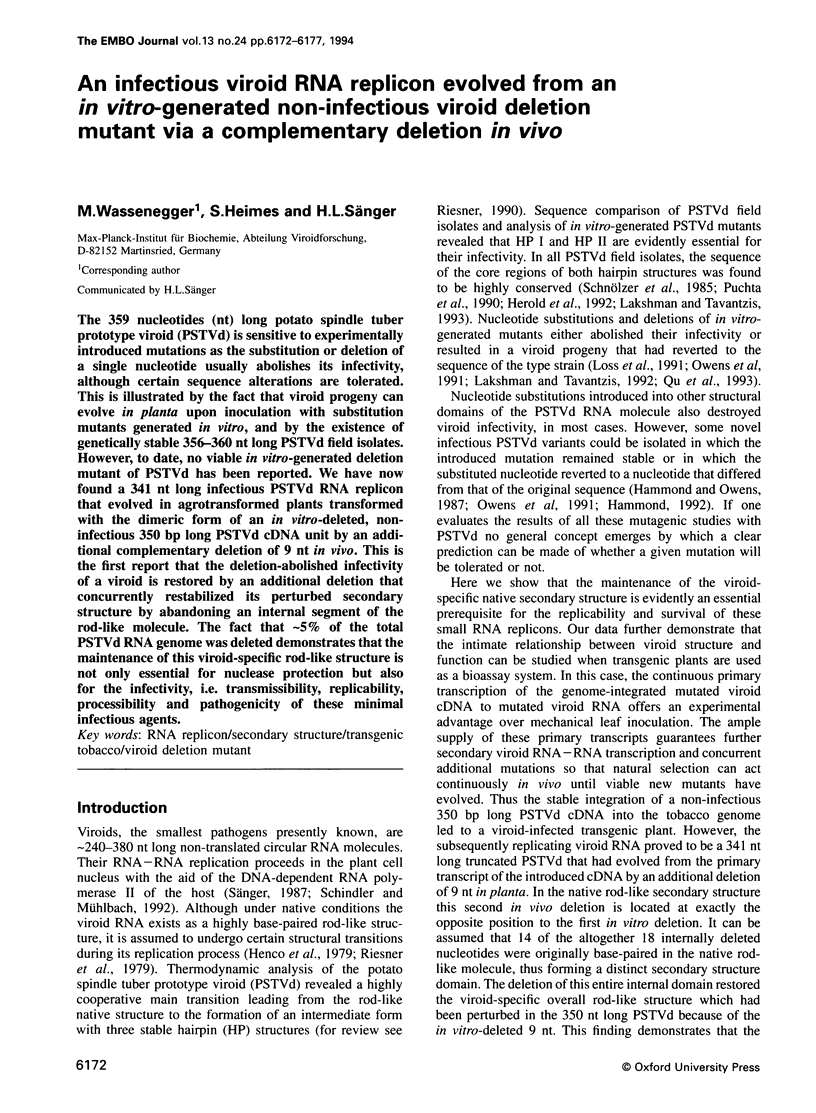
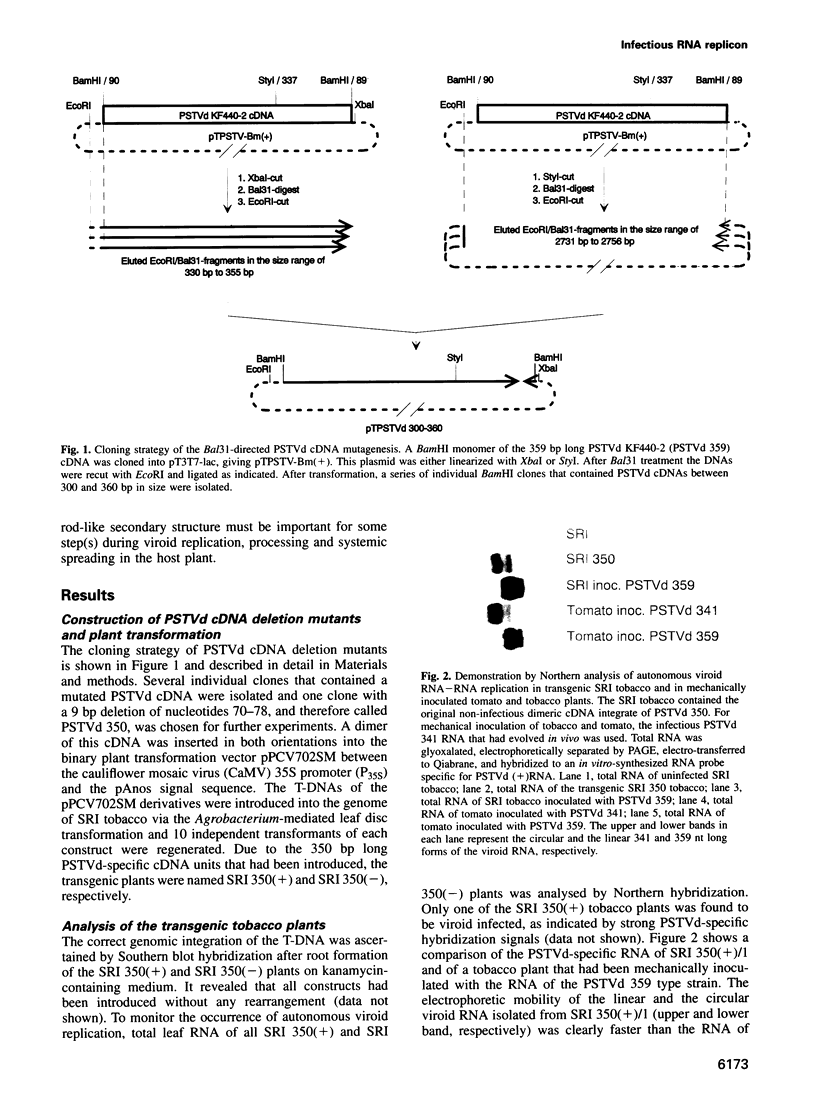
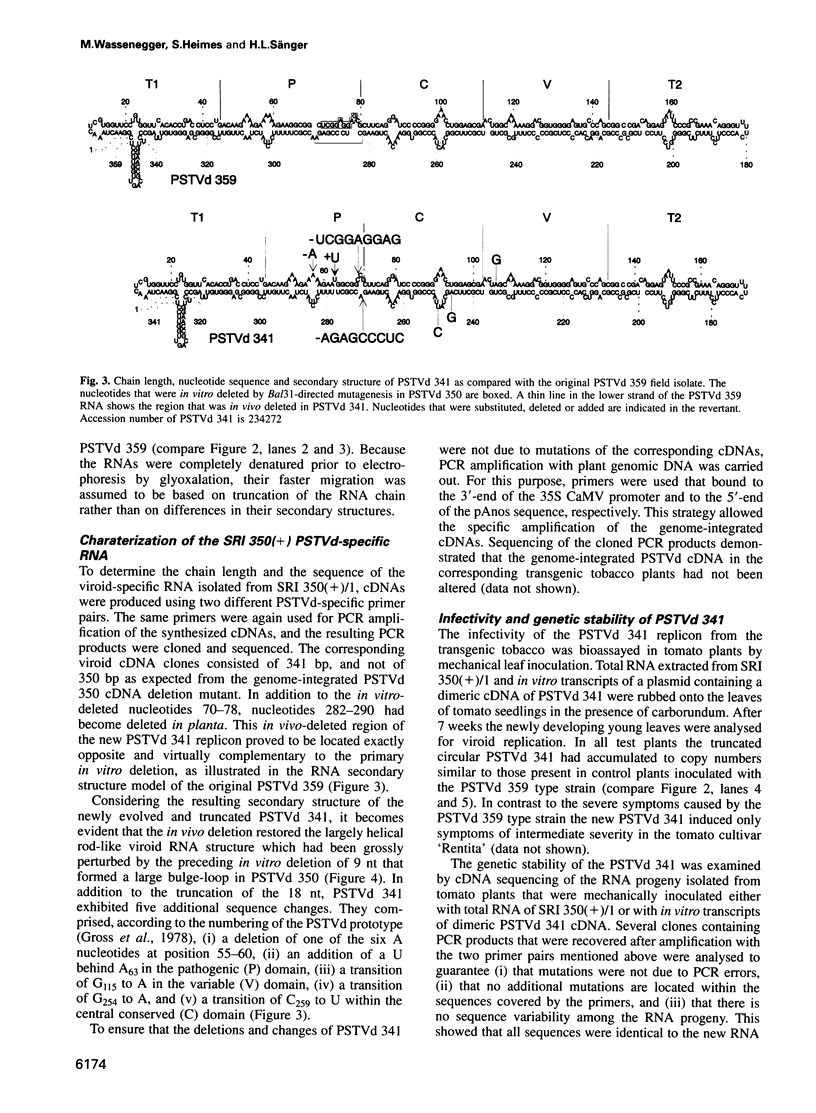
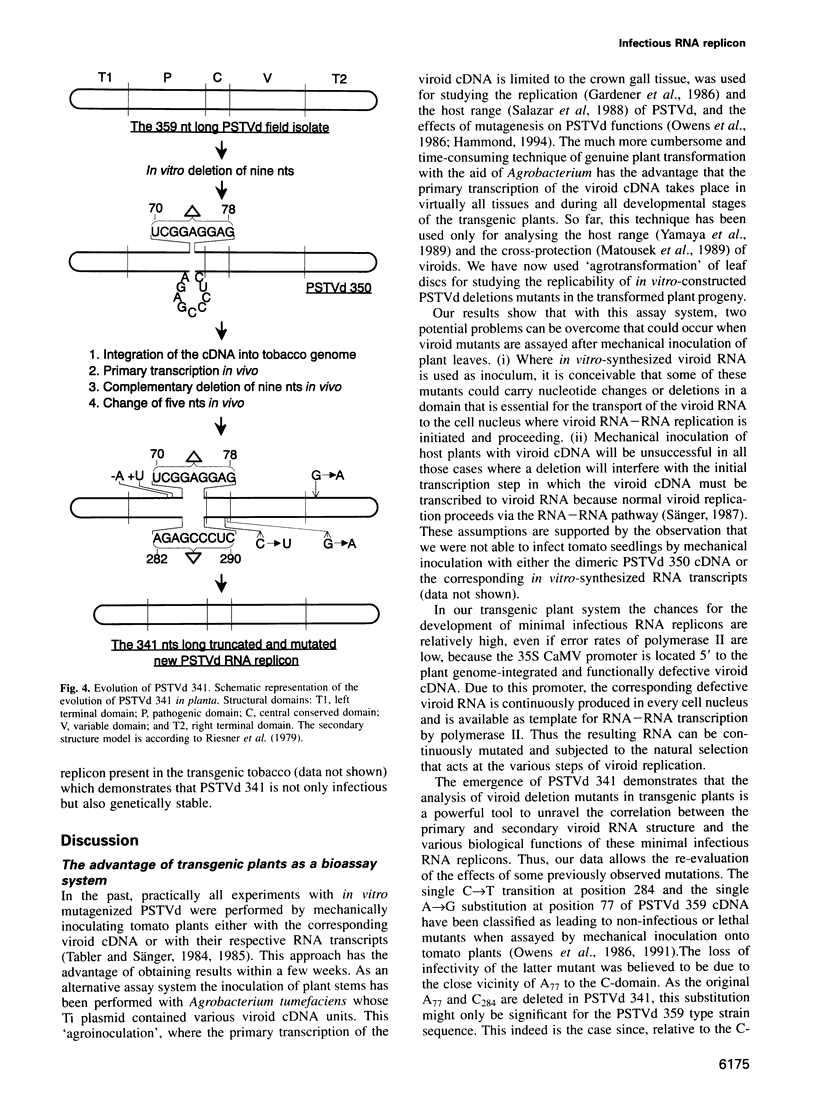
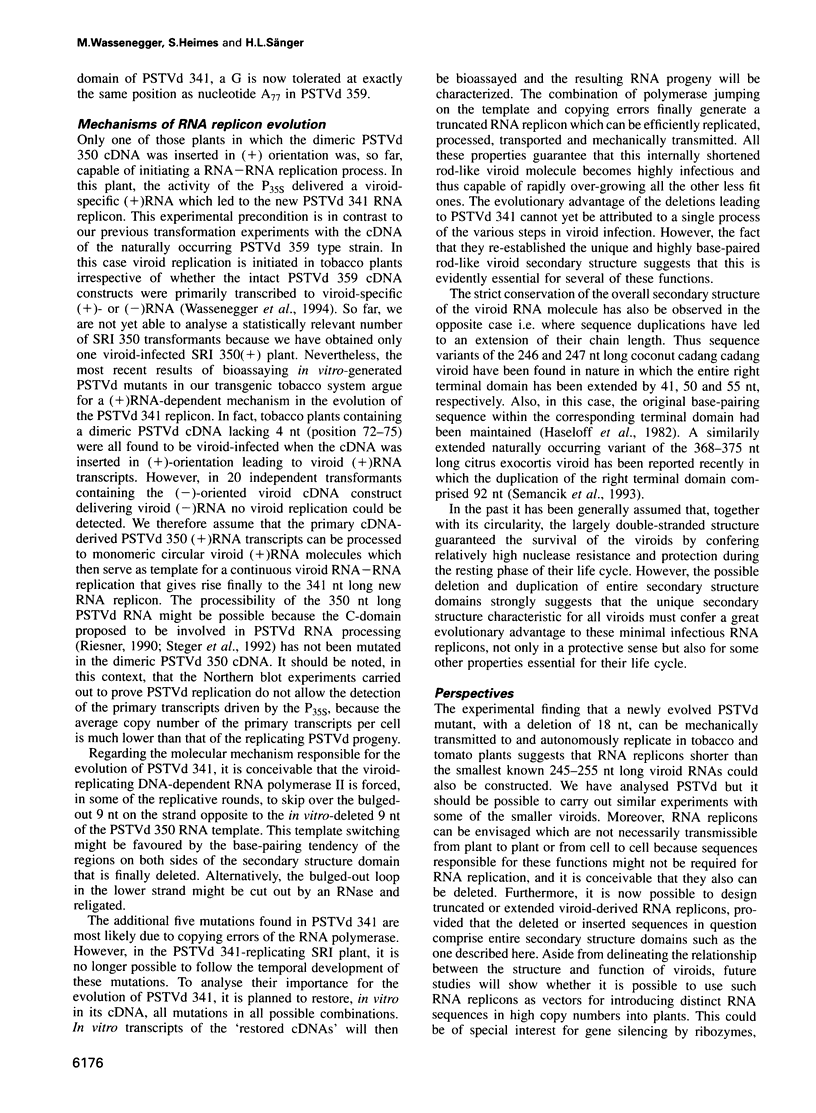
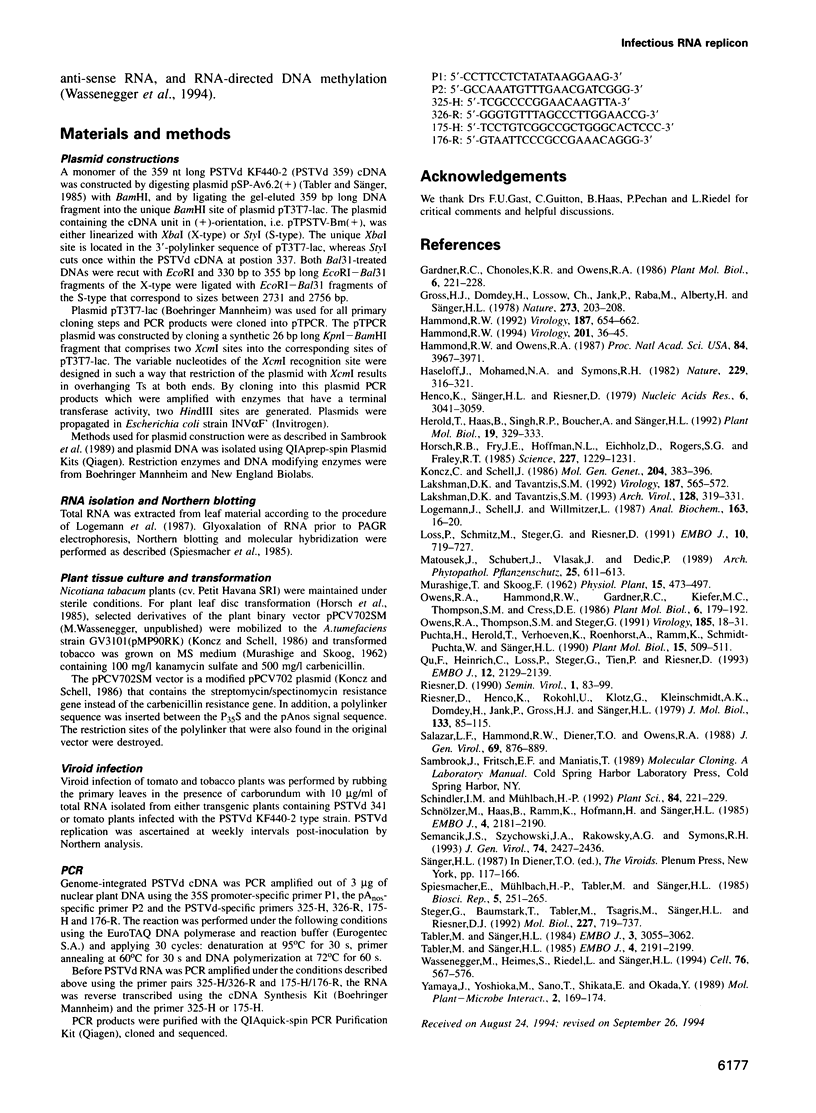
Images in this article
Selected References
These references are in PubMed. This may not be the complete list of references from this article.
- A simple and general method for transferring genes into plants. Science. 1985 Mar 8;227(4691):1229–1231. doi: 10.1126/science.227.4691.1229. [DOI] [PubMed] [Google Scholar]
- Gross H. J., Domdey H., Lossow C., Jank P., Raba M., Alberty H., Sänger H. L. Nucleotide sequence and secondary structure of potato spindle tuber viroid. Nature. 1978 May 18;273(5659):203–208. doi: 10.1038/273203a0. [DOI] [PubMed] [Google Scholar]
- Hammond R. W. Agrobacterium-mediated inoculation of PSTVd cDNAs onto tomato reveals the biological effect of apparently lethal mutations. Virology. 1994 May 15;201(1):36–45. doi: 10.1006/viro.1994.1263. [DOI] [PubMed] [Google Scholar]
- Hammond R. W. Analysis of the virulence modulating region of potato spindle tuber viroid (PSTVd) by site-directed mutagenesis. Virology. 1992 Apr;187(2):654–662. doi: 10.1016/0042-6822(92)90468-5. [DOI] [PubMed] [Google Scholar]
- Hammond R. W., Owens R. A. Mutational analysis of potato spindle tuber viroid reveals complex relationships between structure and infectivity. Proc Natl Acad Sci U S A. 1987 Jun;84(12):3967–3971. doi: 10.1073/pnas.84.12.3967. [DOI] [PMC free article] [PubMed] [Google Scholar]
- Henco K., Sänger H. L., Riesner D. Fine structure melting of viroids as studied by kinetic methods. Nucleic Acids Res. 1979 Jul 11;6(9):3041–3059. doi: 10.1093/nar/6.9.3041. [DOI] [PMC free article] [PubMed] [Google Scholar]
- Herold T., Haas B., Singh R. P., Boucher A., Sänger H. L. Sequence analysis of five new field isolates demonstrates that the chain length of potato spindle tuber viroid (PSTVd) is not strictly conserved but as variable as in other viroids. Plant Mol Biol. 1992 May;19(2):329–333. doi: 10.1007/BF00027356. [DOI] [PubMed] [Google Scholar]
- Lakshman D. K., Tavantzis S. M. Primary and secondary structure of a 360-nucleotide isolate of potato spindle tuber viroid. Arch Virol. 1993;128(3-4):319–331. doi: 10.1007/BF01309442. [DOI] [PubMed] [Google Scholar]
- Lakshman D. K., Tavantzis S. M. RNA progeny of an infectious two-base deletion cDNA mutant of potato spindle tuber viroid (PSTV) acquire two nucleotides in Planta. Virology. 1992 Apr;187(2):565–572. doi: 10.1016/0042-6822(92)90459-3. [DOI] [PubMed] [Google Scholar]
- Logemann J., Schell J., Willmitzer L. Improved method for the isolation of RNA from plant tissues. Anal Biochem. 1987 May 15;163(1):16–20. doi: 10.1016/0003-2697(87)90086-8. [DOI] [PubMed] [Google Scholar]
- Loss P., Schmitz M., Steger G., Riesner D. Formation of a thermodynamically metastable structure containing hairpin II is critical for infectivity of potato spindle tuber viroid RNA. EMBO J. 1991 Mar;10(3):719–727. doi: 10.1002/j.1460-2075.1991.tb08002.x. [DOI] [PMC free article] [PubMed] [Google Scholar]
- Owens R. A., Thompson S. M., Steger G. Effects of random mutagenesis upon potato spindle tuber viroid replication and symptom expression. Virology. 1991 Nov;185(1):18–31. doi: 10.1016/0042-6822(91)90749-2. [DOI] [PubMed] [Google Scholar]
- Puchta H., Herold T., Verhoeven K., Roenhorst A., Ramm K., Schmidt-Puchta W., Sänger H. L. A new strain of potato spindle tuber viroid (PSTVd-N) exhibits major sequence differences as compared to all other PSTVd strains sequenced so far. Plant Mol Biol. 1990 Sep;15(3):509–511. doi: 10.1007/BF00019169. [DOI] [PubMed] [Google Scholar]
- Qu F., Heinrich C., Loss P., Steger G., Tien P., Riesner D. Multiple pathways of reversion in viroids for conservation of structural elements. EMBO J. 1993 May;12(5):2129–2139. doi: 10.1002/j.1460-2075.1993.tb05861.x. [DOI] [PMC free article] [PubMed] [Google Scholar]
- Riesner D., Henco K., Rokohl U., Klotz G., Kleinschmidt A. K., Domdey H., Jank P., Gross H. J., Sänger H. L. Structure and structure formation of viroids. J Mol Biol. 1979 Sep 5;133(1):85–115. doi: 10.1016/0022-2836(79)90252-3. [DOI] [PubMed] [Google Scholar]
- Schnölzer M., Haas B., Raam K., Hofmann H., Sänger H. L. Correlation between structure and pathogenicity of potato spindle tuber viroid (PSTV). EMBO J. 1985 Sep;4(9):2181–2190. doi: 10.1002/j.1460-2075.1985.tb03913.x. [DOI] [PMC free article] [PubMed] [Google Scholar]
- Semancik J. S., Szychowski J. A., Rakowski A. G., Symons R. H. Isolates of citrus exocortis viroid recovered by host and tissue selection. J Gen Virol. 1993 Nov;74(Pt 11):2427–2436. doi: 10.1099/0022-1317-74-11-2427. [DOI] [PubMed] [Google Scholar]
- Spiesmacher E., Mühlbach H. P., Tabler M., Sänger H. L. Synthesis of (+) and (-) RNA molecules of potato spindle tuber viroid (PSTV) in isolated nuclei and its impairment by transcription inhibitors. Biosci Rep. 1985 Mar;5(3):251–265. doi: 10.1007/BF01119595. [DOI] [PubMed] [Google Scholar]
- Steger G., Baumstark T., Mörchen M., Tabler M., Tsagris M., Sänger H. L., Riesner D. Structural requirements for viroid processing by RNase T1. J Mol Biol. 1992 Oct 5;227(3):719–737. doi: 10.1016/0022-2836(92)90220-e. [DOI] [PubMed] [Google Scholar]
- Tabler M., Sänger H. L. Cloned single- and double-stranded DNA copies of potato spindle tuber viroid (PSTV) RNA and co-inoculated subgenomic DNA fragments are infectious. EMBO J. 1984 Dec 20;3(13):3055–3062. doi: 10.1002/j.1460-2075.1984.tb02257.x. [DOI] [PMC free article] [PubMed] [Google Scholar]
- Tabler M., Sänger H. L. Infectivity studies on different potato spindle tuber viroid (PSTV) RNAs synthesized in vitro with the SP6 transcription system. EMBO J. 1985 Sep;4(9):2191–2199. doi: 10.1002/j.1460-2075.1985.tb03914.x. [DOI] [PMC free article] [PubMed] [Google Scholar]
- Wassenegger M., Heimes S., Riedel L., Sänger H. L. RNA-directed de novo methylation of genomic sequences in plants. Cell. 1994 Feb 11;76(3):567–576. doi: 10.1016/0092-8674(94)90119-8. [DOI] [PubMed] [Google Scholar]



